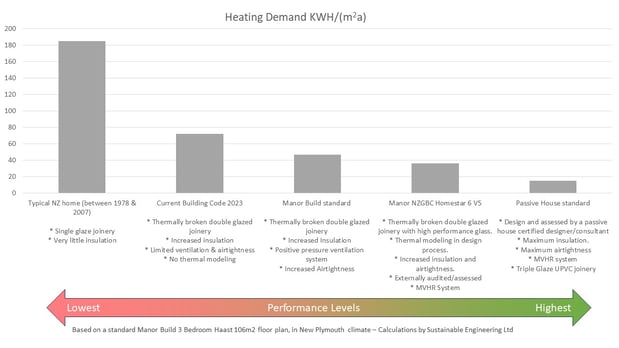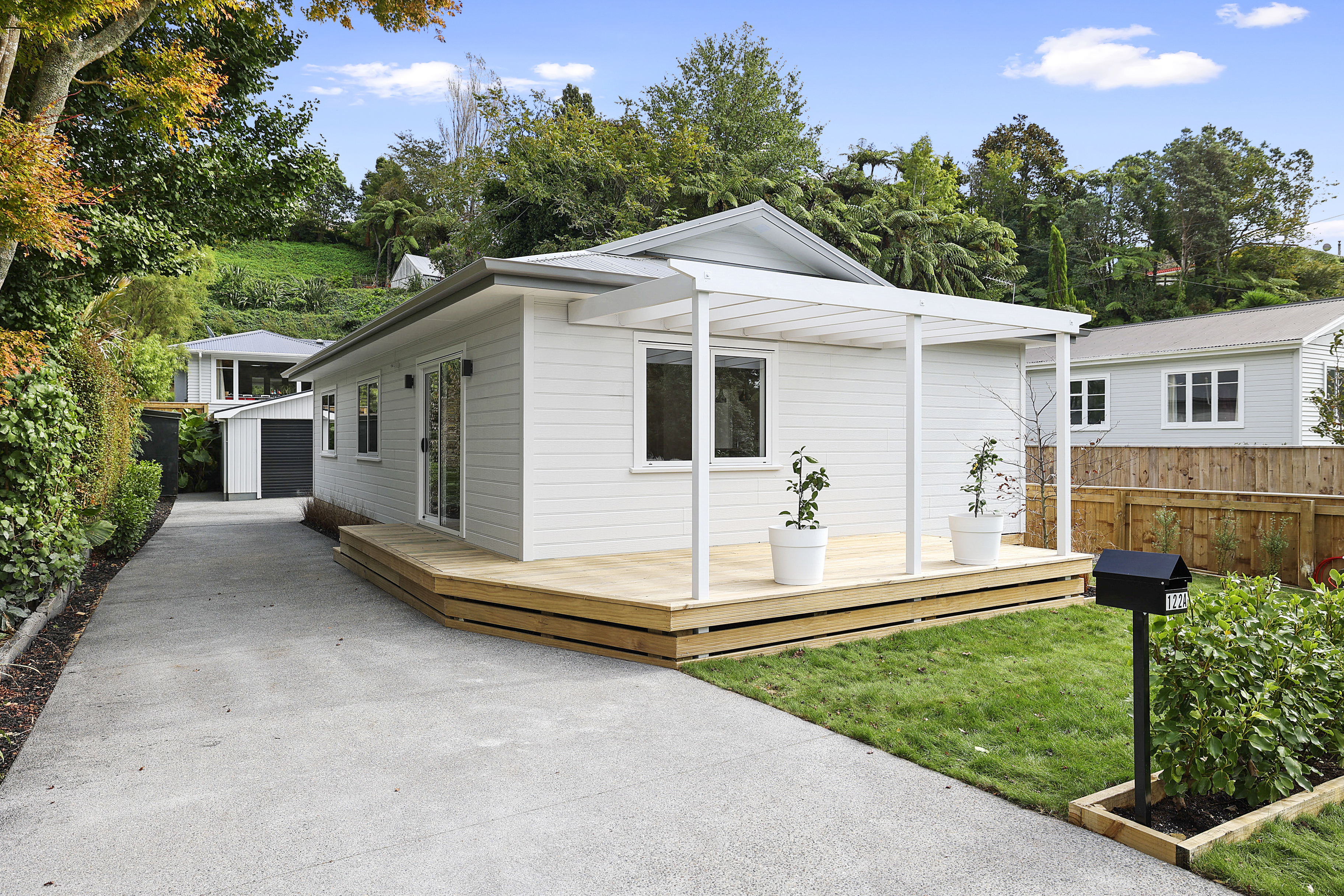What is a high-performance home?

Are you thinking about building a new home? It can be daunting to know where to start so we’ve covered everything you should know about high-performance homes in this article.
We explain the minimum building standards, what a passive and high-performance home is, the key benefits, the potential barriers in your way, and the design elements that make your new home more energy efficient.
Minimum Building Standards NZ
As a minimum standard, all new buildings in New Zealand are subject to the Building Code. This ensures all buildings are safe, healthy, built to last, and compliant with national requirements. The Building Code covers minimum standards for stability, fire protection, access, moisture, safety, services and facilities, and energy efficiency.
However, it is possible to design and build a house that exceeds these requirements, thereby achieving a high-performing building.
What is a high-performance home?
The primary function of a house is to provide shelter and provide a functional space for you to live your life. A high-performance home is designed to optimise the health and well-being of occupants while consuming very little energy. A passive house is the highest performance standard on the spectrum of high-performance homes and generally takes, according to GenLess, 90 to 95% less energy per year to heat than a standard house.
High-performance homes prioritise the following:
-
Energy efficiency
-
Ventilation and air quality
-
Durability
-
Accessibility
-
Water usage
Below, we compare a few different performance standards, based on the energy required to heat a home in New Zealand. In this example, heat demand is measured in KWH/(m2a).

There have been massive changes to the Building Code in the last few decades, resulting in significant improvements to the thermal efficiency of buildings. A 1970s home will use more than twice as much energy to maintain a comfortable temperature than a house built to standard building code in 2023. A Passive house will use only a quarter of the energy to heat a house than a house built to current building code, which is more than 90% saving on a 1970s home!
Benefits of High-Performance Homes
A two-year study commissioned by the New Zealand Business Council for Sustainable Development concluded that by making homes warmer, drier, more energy-efficient, and more water-efficient, New Zealand could achieve the following:
-
Prevent 50 people per day from going to the hospital with respiratory diseases, thereby saving $54 million each year.
-
We could cut the number of sick days taken off work by 180,000 per year, lifting productivity by $31 million per year based on $22PH min wage.
-
By using a combination of insulation and glazing, we could cut household power bills by $475 million per year.
-
Reduce wasted water – equating to 9,200 Olympic swimming pools each year.
Increased quality of life
The principal benefit of a high-performance home is offering a comfortable and healthy interior climate that doesn’t require much energy. This way, you can achieve an ambient temperature year-round without breaking the bank. In other words, you gain a much better quality of life and save significant amounts of money over time.
Why aren’t all homes built to a high-performing standard?
Cost is the number one hurdle for most homeowners when considering a high-performance house. Building to the minimum building regulations is already expensive and high-performance houses typically cost a lot more. However, the long-term savings would pay this off so it is worth investing if you can.
A high-performing house project also requires an increased level of expertise in both the design and build phases. Requirements go well beyond standard architecture, particularly with regard to thermal modelling. For tradespeople, there is a requirement for specialist training so the construction details meet the stringent requirements of the design.
Fortunately, at Manor Build, we overcome these challenges for you and ensure your home is energy-efficient and built to last. With our off-site prefab construction, we significantly reduce building costs and offer improved energy efficiency as a minimum standard. We also offer a range of optional upgrades to comply with high-performance requirements.
How to build a high-performing home
-
5 key Drivers of Thermal Efficiency
One of the main advantages of a high-performing house is that it is easy to maintain a comfortable temperature at all times, without consuming too much energy.
1.1 Improved Insulation
Insulation - Not only does it require insulation with increased thermal resistance, but there is also an understanding of the need to reduce thermal bridges and increase the insulation-to-framing ratio.
1.2 High-performance joinery and glazing
In the past, windows and doors have acted like a hole in the wall, allowing thermal energy to travel in and out. Thermally broken double-glazed Low-E joinery is now the standard in new build homes around New Zealand, which is a big improvement on historical systems. There are also options to offer a much higher performance, such as with UPVC and/or triple glazing.
1.3 Airtightness
With an airtight building, managing the internal temperature is much easier, helping to reduce energy costs. By implementing blower door tests during construction, you can identify any gaps and ensure the trades work to meet this higher performance standard.
1.4 Ventilation
High-performance homes need a constant supply of fresh filtered air throughout the whole house, which can be achieved by using ventilation systems such as positive pressure or balanced Smartvent products. To meet passive house standards a Mechanical Ventilation Heat Recovery system (MVHR) system will be required. MVHR systems supply constant filtered air and recover up to 95% of the extracted air heat into the fresh air flow.
1.5 Simple efficient form factor
In simple terms, the simpler the shape of the building, the easier it is to meet passive energy standards. For example, a complex H-shaped building will have a much higher wall area-to-floor area ratio than a rectangular building, resulting in performance reduction.
2. Material durability
Choosing the right construction materials and products is critical for passive homes. Factors to consider include longevity, sustainable sourcing, and energy conservation. Where possible, try to use materials that will last as long as the house itself and require minimal maintenance.
Here at Manor Build, we use painted Weathertex Weatherboards because they come with a 25-year warranty and durable stainless steel fixings. Other examples include our Armor Steel roofing, Godfrey Hirst Detroit carpet, H3.2 Treated timber subfloor bearers, and H1.2 Floor joists and nogs. See our Standard Inclusions for more.
3. Accessibility
The layout and site design of a passive house must maximise safety and accessibility. At Manor Build, every design is carefully considered to achieve optimum accessibility and internal flow. We will guide you through this process, ensuring the entire home is designed according to your unique lifestyle and needs.
4. Water usage
Tapware specifications that meet flow rate standards such as WELS 4 + will reduce water wastage.
5. Lighting
For high performance houses, energy-efficient LED lighting is required.
6. Thermal modelling
Thermal modelling can be completed by a qualified professional to ensure the home performs effectively in the local climate. This involves checking that the home captures natural solar heat as needed but also doesn’t overheat in summer.
Manor Build Standards
At Manor Build, we have incorporated many of the above disciplines into our standard process, resulting in an affordable high-performance home. In fact, our standard specification performs 35% better than a comparable conventional brick and tile home of a similar size.
Standard specifications:
-
R7.0 Ceiling Insulation.
-
R2.2 Wall insulation with decreased thermal bridging
-
R3.1 Underfloor insulation.
-
Positive Pressure Ventilation.
-
Thermally broken aluminium joinery with Low-E glass.
-
Metrapanel ceilings and floors which provide an airtight layer.
-
Full RAB board wrap on all walls.
-
Simple form factor on all standard builds (See plans here).
-
Timber Framed Floor – easier to make thermally efficient than concrete floors.
-
Weathertex cladding (better than zero carbon footprint).
-
Factory-built to reduce waste and travel time.
-
Efficient tapware.
-
LED lighting.
Optional upgrades:
-
Optional ventilation upgrades to heat transfer, balanced, and MVHR, if required.
-
Optional upgrades to triple-glazed or UPVC joinery are available.
-
A blower door test for airtightness is available as required for certification.
Interested in living a healthy and comfortable lifestyle but not prepared to pay the typical cost of a high-performance home? We can help. Contact us today to enquire about our standard builds, or ask about upgrading your Manor Build prefab to Homestar 6 standards or other high-performance building standards. Alternatively, download our free brochure to discover our full range of high-performing prefab homes.
Tags: Transportable/Prefab home High Performance Homes

.jpeg)


